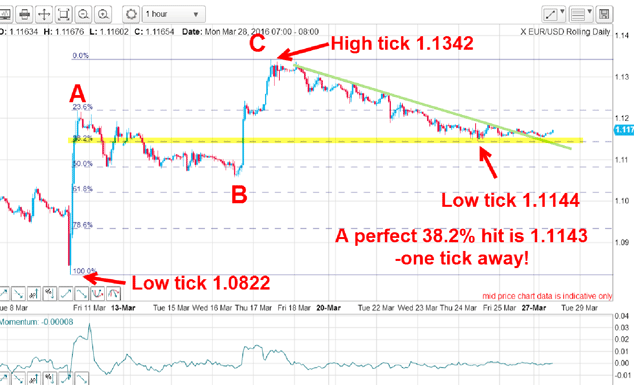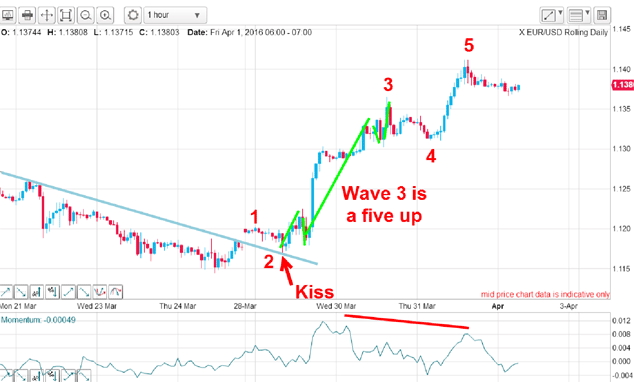Searching for an exit in my euro trade
Swing traders face hard decisions, says John C Burford. But the sooner they are made, the better the long-term results.
Since I believe that for swing traders and long-term investors alike, the decision of when and where to exit a position is a far more difficult decision than its entry, I will today follow up on my EUR/USD trade saga that I have related in recent posts.
Previously, I have explained how I use my tramline methods to pinpoint a precise trade entry and to evaluate an appropriate stop loss which limits my maximum loss to 3% of my account if I am wrong.
This was the entry I made as shown in the chart I showed on Wednesday:
Subscribe to MoneyWeek
Subscribe to MoneyWeek today and get your first six magazine issues absolutely FREE

Sign up to Money Morning
Don't miss the latest investment and personal finances news, market analysis, plus money-saving tips with our free twice-daily newsletter
Don't miss the latest investment and personal finances news, market analysis, plus money-saving tips with our free twice-daily newsletter

The lowest tick off the C wave high was one tick away from the accurate 38.2% retrace of the entire move up off the wave A low. What an incredible demonstration of the power of Fibonacci.
That was the ideal entry point of course, where a very close stop of a tiny 20 pips could safely be employed. But what if you were a trader of a more cautious disposition and wanted more proof of an upturn?
One further clue that the trend was about to turn up would be provided by an upside break of the blue trendline. That is a typical entry signal used by myself and many others who use different trading methods.
You could have placed a buy stop just above the line to catch any possible rally and this technique is much more useful for traders who are unable to constantly monitor their trades. In other words, they have better things to do, such as go to work.
Of course, using this technique necessitates use of a wider stop so there is a price to pay.
Right away I had a winning trade as the market staged a 'Yellen rally' on Tuesday. This is the updated hourly chart:

But first, note the trendline break (wave 1), then the kiss (wave 2) and then the strong wave 3 rally. And this third wave also contains its own five up. This is total textbook stuff.
Following the typical three down wave 4, the market made new highs last night in what could be the final wave 5. At that point, the open profit on my long trade was over 200 pips, which represents a reward/risk ratio of around 20. I don't have to tell experienced traders that this is a highly desirable result making the trade well worth stalking.
This morning, the market is trying to rally up to my wave 5 high, and I am still faced with the task of deciding when and where to take profits. Naturally, I want to capture as much as possible.
On the downside, I would be concerned if the market dropped down to the wave 4 low and I would have to give up a large chunk of my hard-won gains. I do not want to do that.
But if the market fell back to the recent low at 1.1360, the uptrend would be in jeopardy. So that would be a sensible place to raise my protect-profit sell stop to.
If I did that, it would allow for even more gains if the market continued its uptrend. Alternatively, I could simply exit the trade here, but miss out on any possible upside. It is horses for courses.
And if the rally continued, it would mean that wave 5 was subdividing higher. If that happens, what is the likely turning point? Here is the daily chart:

The rally has carried well above the Fibonacci 62% level where most turns are made. The next heavy resistance lies at the 78% level at around 1.1450, which is about 70 pips from current. That would be a nice addition to profits.
But it may not get there. Momentum is weakening and if my A-B-C labels are correct, a turn can come at any time.
This is a typical dilemma faced by swing traders, but must be faced with courage. Hard decisions must be made and I have found that the sooner they are made, the better the long-term results. Procrastination is usually fatal.
Get the latest financial news, insights and expert analysis from our award-winning MoneyWeek team, to help you understand what really matters when it comes to your finances.
John is is a British-born lapsed PhD physicist, who previously worked for Nasa on the Mars exploration team. He is a former commodity trading advisor with the US Commodities Futures Trading Commission, and worked in a boutique futures house in California in the 1980s.
He was a partner in one of the first futures newsletter advisory services, based in Washington DC, specialising in pork bellies and currencies. John is primarily a chart-reading trader, having cut his trading teeth in the days before PCs.
As well as his work in the financial world, he has launched, run and sold several 'real' businesses producing 'real' products.
-
 Will “Liberation Day” strike again?
Will “Liberation Day” strike again?Donald Trump’s 90-day tariff pause comes to an end on 9 July. Can we expect further market turmoil?
-
 Israel claims victory in the '12-day war' with Iran
Israel claims victory in the '12-day war' with IranDonald Trump may have announced a ceasefire in the 12-day war between Israel and Iran, but what comes next depends on what happens internally in Iran